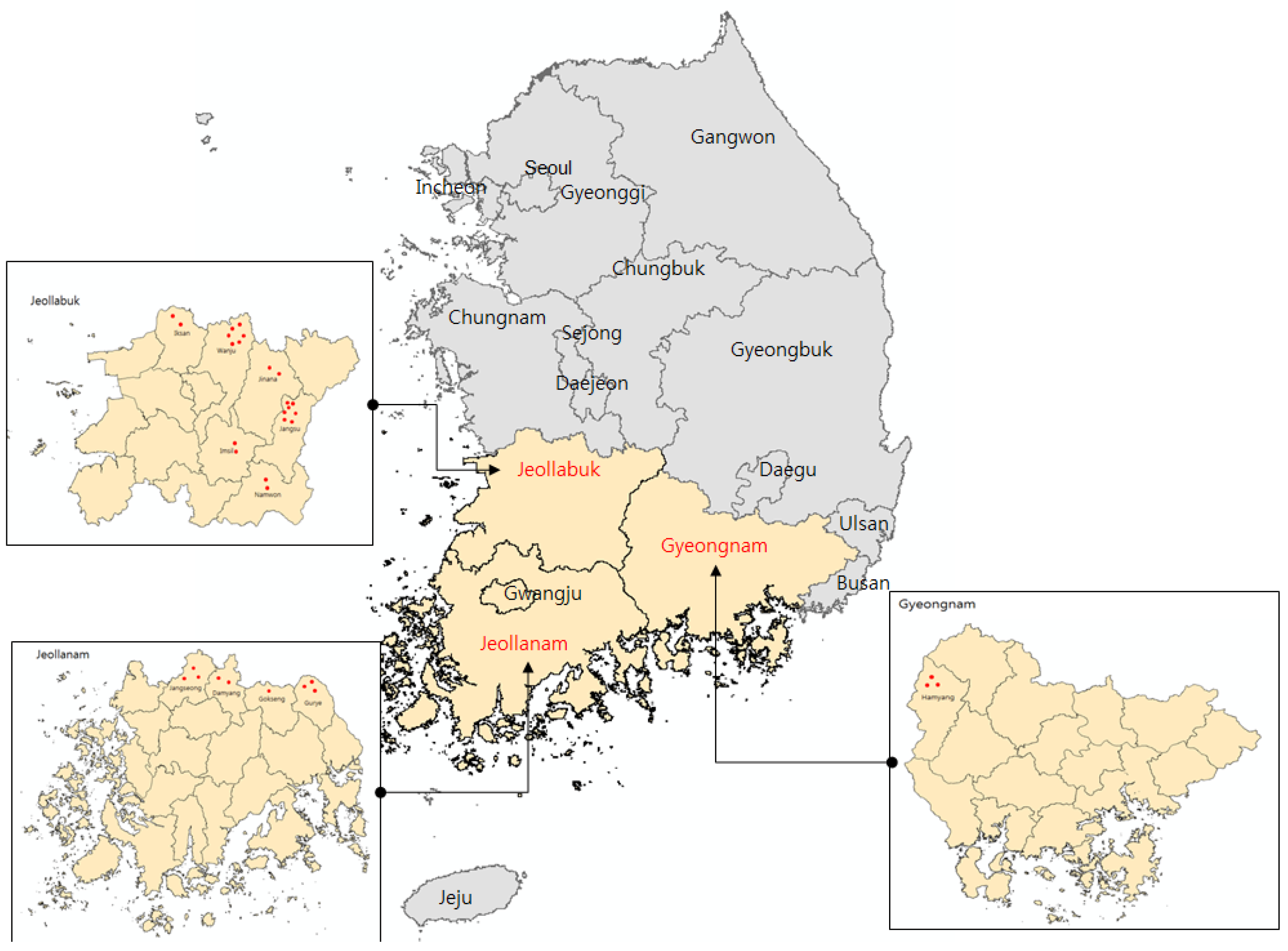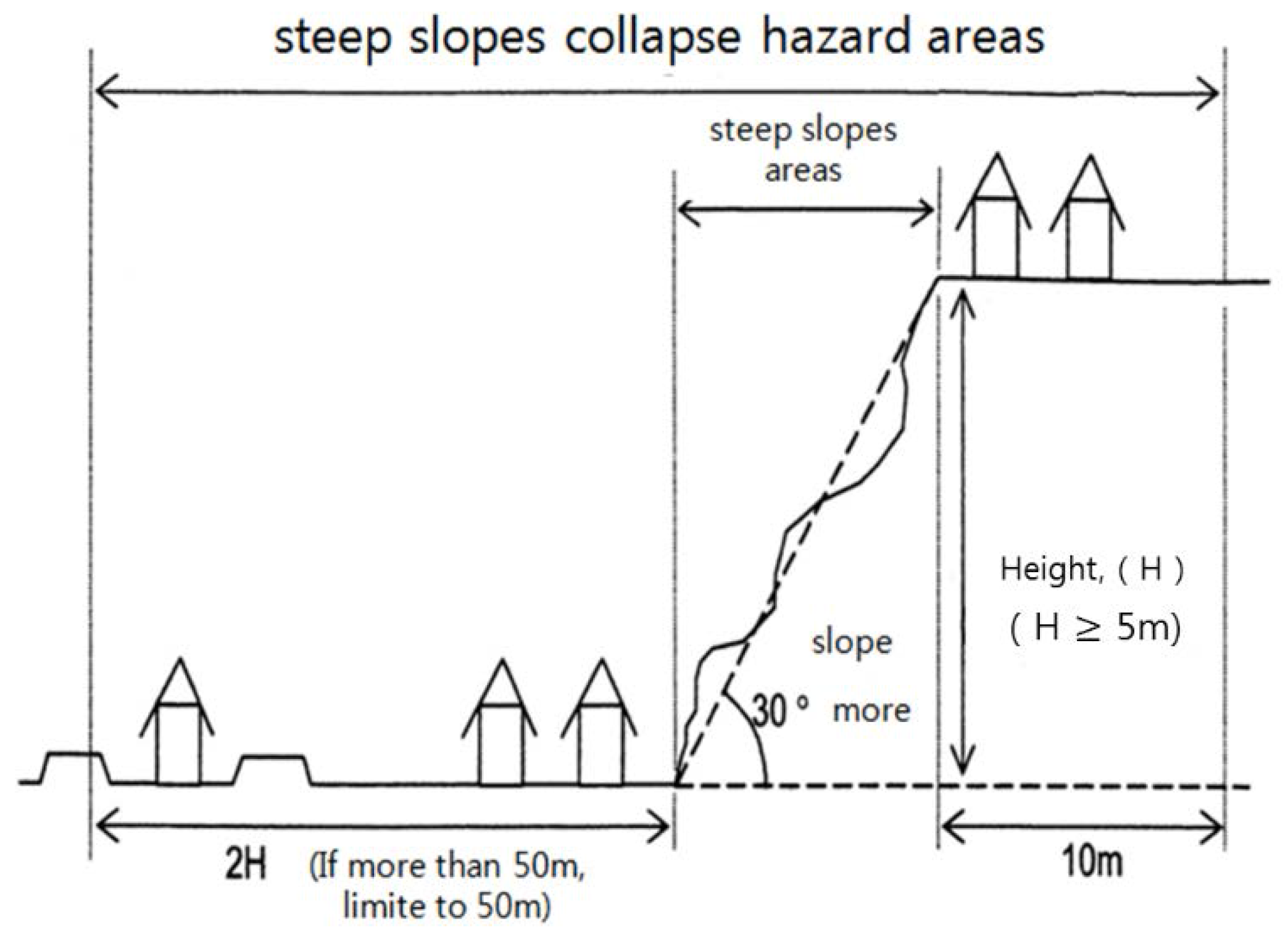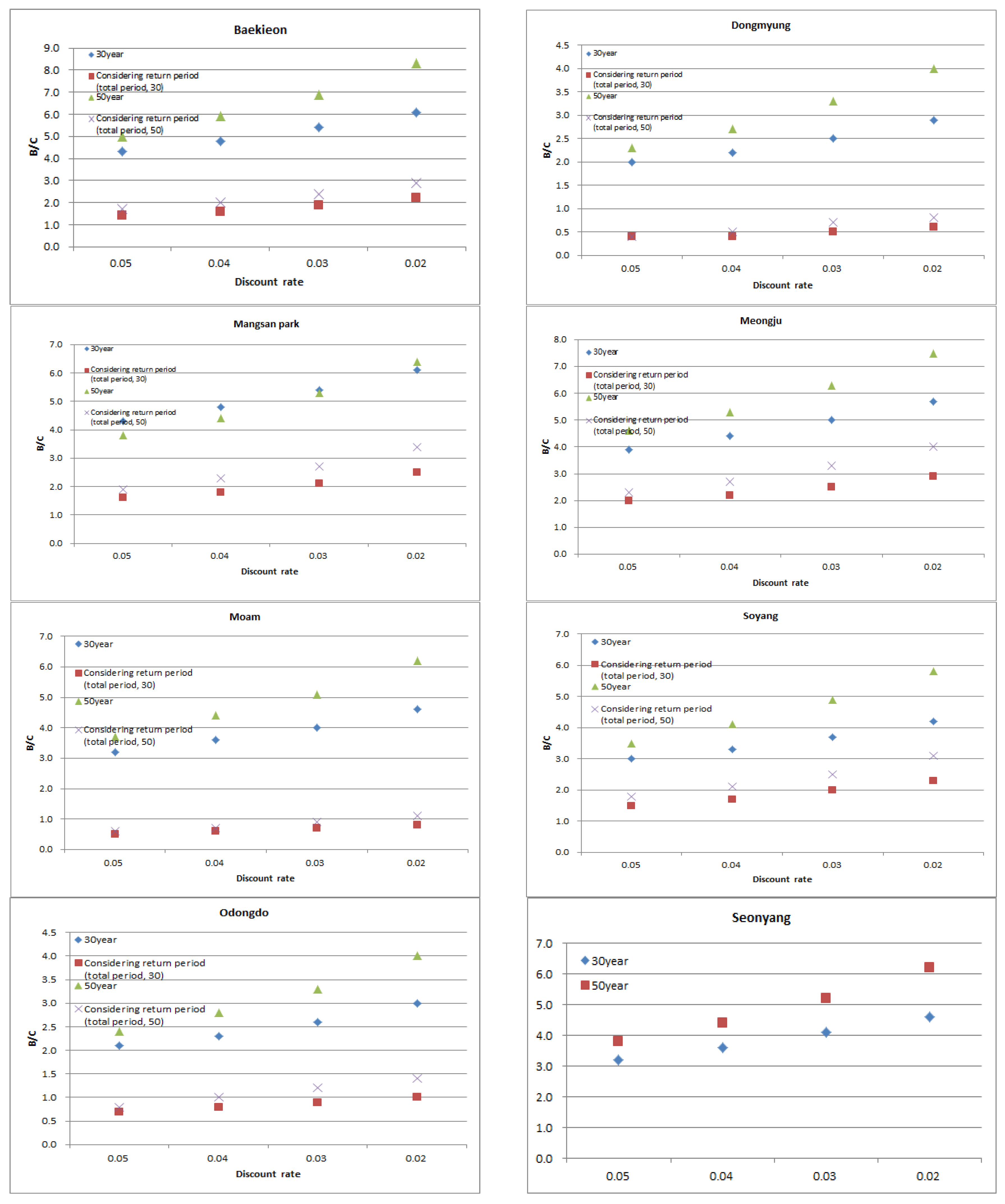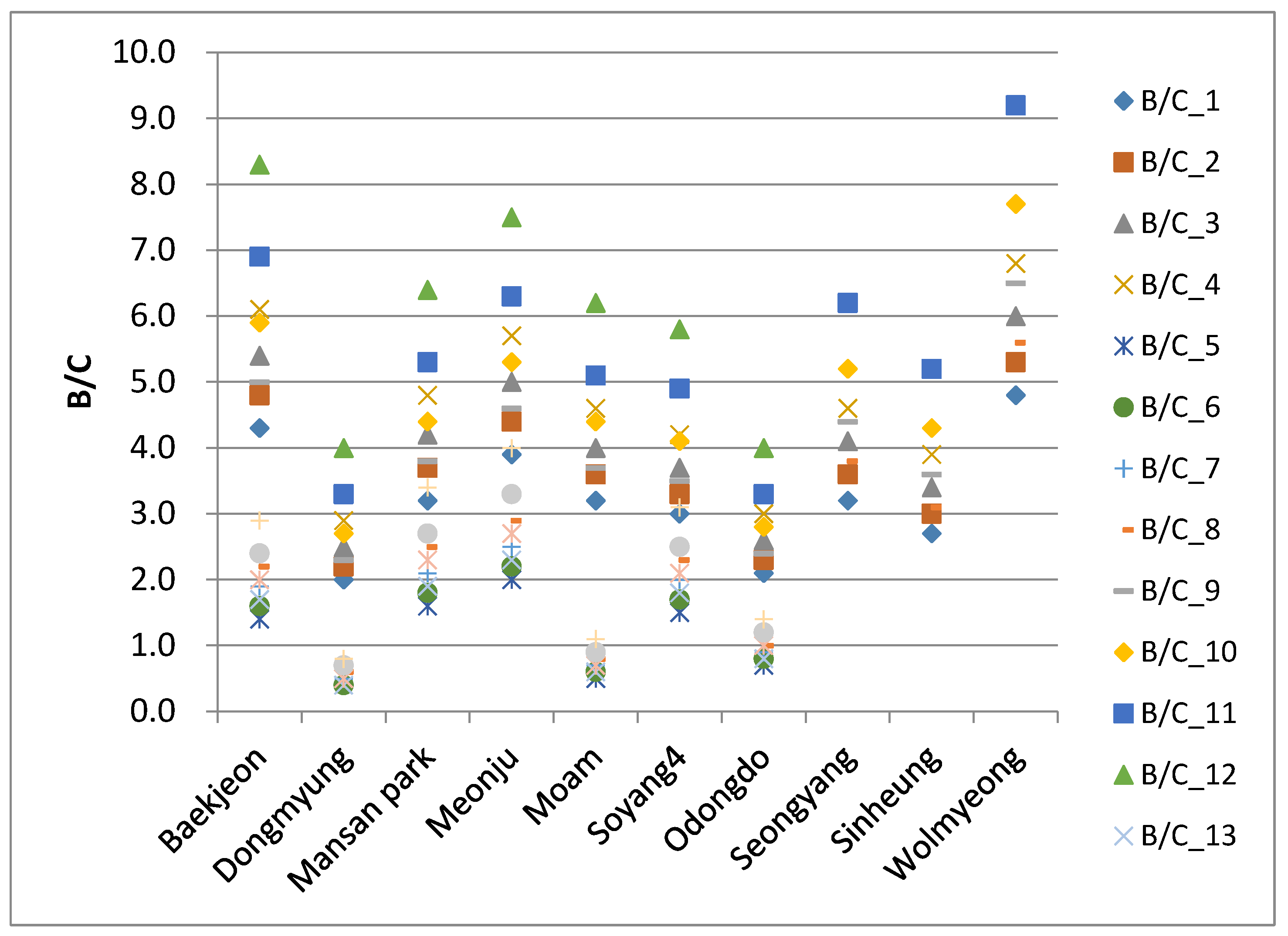Economic Analysis for Collapse Hazard Areas
Abstract
:1. Introduction
2. Current Status of Natural Disaster Hazard Zone Follow-Up Repair Programs
3. Materials and Methods
3.1. Determining Analysis Areas
3.2. Analysis Method
4. Results of Analysis
5. Conclusions
Author Contributions
Conflicts of Interest
References
- Mechler, R. Cost-Benefit Analysis of Natural Disaster Risk Management in Developing and Emerging Countries; Federal Ministry for Economic Cooperation and Development: Bonn, Germany, 2005.
- Kim, G.M.; Kim, T.S.; Park, T.S.; Lee, Y.J.; Song, M.K. Study on the Measures of Improving Analysis of Economic Values of Water Conservation Project; Ministry of Land, Infrastructure, Transport and Tourism: Sejong-si, Korea, 2001.
- Mechler, R. Semarang Case Study. In Interim Report for GTZ; Federal Ministry for Economic Cooperation and Development: Bonn, Germany, 2004. [Google Scholar]
- Federal Emergency Management Agency (FEMA). FY 2006 Pre-Disaster Mitigation Program—Guidance; FEMA: Cleveland, OH, USA, 2006.
- Lee, S.W. Economic Implications of 4 Great Rivers Revitalization Project; Korea Water Resources Association: Seoul, Korea, 2009. [Google Scholar]
- Benson, C. The cost of disasters. In Development at Risk? Natural Disasters and the Third World; Twigg, J., Ed.; Oxford Centre for Disaster Studies: Oxford, UK, 1988. [Google Scholar]
- International Federation of Red Cross and Red Crescent (IFRC). World Disasters Report 2002; IFRC: Geneva, Switzerland, 2002. [Google Scholar]
- Venton, C.; Venton, P. Disaster Preparedness Programmes in India: A Cost Benefit Analysis; Humanitarian Practice Network: London, UK, 2004. [Google Scholar]
- National Emergency Management Agency. National Emergency Management a Study on the Research for the Method to Strengthen the Disaster Mitigation Activities and to Increase the Investments; National Emergency Management: Sejong-si, Korea, 2006.
- Natural Disaster Management Institute. Study on the Improvement in the Determination of the Investment Priority for Collapse Hazard Areas; NDMI: Ulsan, Korea, 2011.
- Natural Disaster Management Institute. Study on the Applicability of an Early Warning System Using Rainfall Data in Korea; NDMI: Ulsan, Korea, 2008.
- Ministry of Land, Infrastructure, Transport and Tourism (MITT). Guideline for Cost-Benefit Analysis of Public Projects; MITT: Tokyo, Japan, 2004.
- National Emergency Management Agency. Annual Disaster Report; National Emergency Management Agency: Sejong-si, Korea, 2001–2010.
- National Emergency Management Agency. Guideline for Management of Area Vulnerable to Natural Disaster; Ministry of Public Safety and Security: Sejong-si, Korea, 2012.





| Sources and Data Types | Actual or Potential Benefits | Benefit/Cost Results | |
|---|---|---|---|
| Ex-ante | Mechler [1]: Preliminary feasibility assessment of reclaimed land system in response to floods, Piura, Peru | Reduction of socioeconomic and indirect impacts | 3.8 |
| Mechler [3]: Theoretical study of integrated water management and floods protection plan, Semarang, Indonesia | Reduction of direct and indirect economic impact | 2.5 | |
| FEMA [4]: Disaster mitigation project effects | Reduction of direct and indirect economic impact | 4.0 | |
| Lee [5]: Four River Restoration Project | Reduction of direct and indirect economic impact | More than 1.0 | |
| Ex-post | Benson, C [6]: Post-evaluation methods of flood control has been executed in China for the past 40 years of the 20th century | Unclear, direct damage reduction | 4.0 |
| IFRC [7]: Post-evaluation of “Red Cross Mangrove Planting Project” in order to protect coastal residents from typhoons and storms, Philippines | Savings of embankment maintenance cost | 52.0 (1994–2001) | |
| Venton and Venton [8]: Post-evaluation of combined disaster prevention and preparedness program, Bihar and Andhra Pradesh, India | Reduction of direct and indirect economic impact | 3.76 (Bihar) 13.38 (Andhra Pradesh) | |
| NEMA [9]: Investment in the field of disaster prevention, Korea | Reduction of direct and indirect economic impact | 4.5 | |
| Hazard | Inundation | Washout | Isolation | Collapse | Vulnerable Facilities | Tsunami | Total | |
|---|---|---|---|---|---|---|---|---|
| Status | ||||||||
| Management | 378 | 90 | 14 | 125 | 29 | 11 | 647 | |
| Decommission | 656 | 45 | 13 | 147 | 71 | 6 | 938 | |
| Total | 1034 | 135 | 27 | 272 | 100 | 17 | 1585 | |
| Classification | Standard |
|---|---|
| A | High risk potential for personal injury due to disasters |
| B | Risk potential for damage to buildings (house, shopping center, public building) due to disaster |
| C | Risk potential for damage to infrastructure (industrial complex, railroad, road) due to disaster Agricultural land in flood hazard areas |
| D | Low possibilities of collapse and inundation, but continuous management needed because of climate change |
| Si-Do | Si-Gu | Project Site | Site Area (ha) | Project Period |
|---|---|---|---|---|
| Jeonnam | Yeosu | Odongdo | 2.5 | 2011~2013 |
| Gyeongsangbuk | Sacheon | Mangsan park | 2.47 | 2008~2011 |
| Gyeongsangbuk | Gimcheon | Moam | 2.35 | 2012~2013 |
| Jeonbuk | Gunsan | Wolmyeong | 2.0 | 2010~2011 |
| Jeonbuk | Gunsan | Sinheung | 0.8 | 2010~2013 |
| Jeonbuk | Gunsan | Seonyang | 0.7 | 2010~2011 |
| Gangwon | Sokcho | Dongmyumg | 0.7 | 2007~2011 |
| Gangwon | Chuncheon | Soyang | 0.6 | 2010~2011 |
| Jeonnam | Gwangyang | Myeongiu | 0.3 | 2011~2012 |
| Gyeongsangbuk | Yecheon | Beakieon | 0.05 | 2010~2011 |
| Contents | Unit | Unit Cost (KRW) | ||
|---|---|---|---|---|
| A. Death, missing, injury | Relief fund | Death, Missing (Householder) | Person | 10,000,000 |
| Death, Missing (Family member) | Person | 5,000,000 | ||
| Injury (Householder) | Person | 5,000,000 | ||
| Injury (Family member) | Person | 2,500,000 | ||
| B. Relief of victims | Relief of victims | Relief money | Person/day | 6000 |
| C. Housing recovery | Housing damage | Whole damage/Loss | House | 30,000,000 |
| Half damage | House | 15,000,000 | ||
| D. Agricultural land recovery | Agricultural land Missing or burying | Agricultural land missing | m2 | 2087 |
| Agricultural land buried | m2 | 840 | ||
| E. Road and bridge | Road | Pavement | m | 4,452,000 |
| Establishment | m | 4,828,950 | ||
| Urban road, farming and fishing village road | Urban road | m | 1,340,000 | |
| Farming and fishing village road | m | 790,000 | ||
| F. National park facilities | - | National park facilities route (B = 1.5 m) | km | 351,037,000 |
| G. School facilities | Fence | Brick fence | m2 | 149,000 |
| Block fence | m2 | 104,000 | ||
| Wire fence | m2 | 70,000 | ||
| H. Forest facilities | - | Landslide | ha | 95,940,000 |
| Debris barrier (B = 50 m, H = 8.3 m) | Quantity | 287,539,000 | ||
| Forest road | km | 188,000,000 | ||
| Toilet | - | 1,026,000 | ||
| Arboretum—Forest seedbed | - | 5000 | ||
| Greenhouse | - | 80,000 | ||
| Ecology observation route | km | 125,499,000 | ||
| Lounge | - | 1,512,000 | ||
| Street trees | - | 121,000 | ||
| Project Site | Cost (USD Million) | Project Site | Cost (USD Million) |
|---|---|---|---|
| Odongdo | 16.0 | Seonyang | 6.5 |
| Mangsan Park | 3.7 | Dongmyumg | 5.0 |
| Moam | 8.0 | Soyang | 3.3 |
| Wolmyeong | 5.0 | Myeongiu | 1.2 |
| Sinheung | 15.0 | Beakieon | 2.6 |
| Country | Discount Rate | Source |
|---|---|---|
| Britain | 3.5% | The Green Book: Appraisal and Evaluation in Central Government, 2003.1 H.M. Treasury Guidance, 2003 |
| India | 3% | Macro-Economic Evaluation of Transport Infrastructure Investments, Evaluation Guidelines for the Federal Transport Investment Plan, The Federal Minister of Transport, 1992 |
| Belgium | 4% | Assessing the Benefits of Transport, ECMT, 2001 |
| France | 8% | Assessing the Benefits of Transport, ECMT, 2001 |
| Sweden | 4% | Assessing the Benefits of Transport ECMT, 2001 |
| New Zealand | 10% | Evaluation Procedures for Alternatives to Roading, Transfund New Zealand |
| Asian Development Bank | 10–12% | Guidelines for the Economic Analysis of Projects, 1997 |
| Damage (Unit Cost (KRW)) | |||||||||||
|---|---|---|---|---|---|---|---|---|---|---|---|
| Project Site | 2001 | 2002 | 2003 | 2004 | 2005 | 2006 | 2007 | 2008 | 2009 | 2010 | Return Period (year) |
| Baekieon | 73,160,000 | 52,747,000 | 319,698,000 | 0 | 0 | 0 | 0 | 0 | 0 | 0 | 3.33 |
| Moam | 0 | 10,111,134,000 | 6,670,015,000 | 0 | 0 | 0 | 0 | 0 | 0 | 0 | 5.00 |
| Odongdo | 0 | 864,710,000 | 1,561,473,000 | 0 | 0 | 492,308,000 | 0 | 0 | 0 | 0 | 3.33 |
| Dongmyung | 0 | 1,130,057,000 | 148,094,000 | 0 | 0 | 0 | 0 | 0 | 0 | 0 | 5.00 |
| Soyang | 779,293,000 | 1,140,178,000 | 87,249,000 | 0 | 0 | 3,704,123,000 | 0 | 0 | 1,670,263,000 | 0 | 2.00 |
| Mangsan Park | 645,444,000 | 591,657,000 | 3,782,842,000 | 0 | 91,407,000 | 1,067,638,000 | 0 | 0 | 0 | 0 | 2.00 |
| Myeongiu | 0 | 2,649,450,000 | 1,109,929,000 | 0 | 0 | 698,702,000 | 131,625,000 | 0 | 4,265,765,000 | 0 | 2.00 |
| Seonyang | 0 | 0 | 0 | 0 | 0 | 0 | 0 | 0 | 0 | 0 | - |
| Sinheung | 0 | 0 | 0 | 0 | 0 | 0 | 0 | 0 | 0 | 0 | - |
| Wolmyeong | 0 | 0 | 0 | 0 | 0 | 0 | 0 | 0 | 0 | 0 | - |
| Classification | Analysis Period | Discount Rate | Classification | Analysis Period | Discount Rate |
|---|---|---|---|---|---|
| B/C_1 | 30 years | 5% | B/C_9 | 50 years | 5% |
| B/C_2 | 4% | B/C_10 | 4% | ||
| B/C_3 | 3% | B/C_11 | 3% | ||
| B/C_4 | 2% | B/C_12 | 2% | ||
| B/C_5 | Considering return period (total period, 30) | 5% | B/C_13 | Considering return period (total period, 50) | 5% |
| B/C_6 | 4% | B/C_14 | 4% | ||
| B/C_7 | 3% | B/C_15 | 3% | ||
| B/C_8 | 2% | B/C_16 | 2% |
© 2017 by the authors. Licensee MDPI, Basel, Switzerland. This article is an open access article distributed under the terms and conditions of the Creative Commons Attribution (CC BY) license (http://creativecommons.org/licenses/by/4.0/).
Share and Cite
Heo, B.-Y.; Heo, W.-H. Economic Analysis for Collapse Hazard Areas. Appl. Sci. 2017, 7, 693. https://doi.org/10.3390/app7070693
Heo B-Y, Heo W-H. Economic Analysis for Collapse Hazard Areas. Applied Sciences. 2017; 7(7):693. https://doi.org/10.3390/app7070693
Chicago/Turabian StyleHeo, Bo-Young, and Won-Ho Heo. 2017. "Economic Analysis for Collapse Hazard Areas" Applied Sciences 7, no. 7: 693. https://doi.org/10.3390/app7070693





